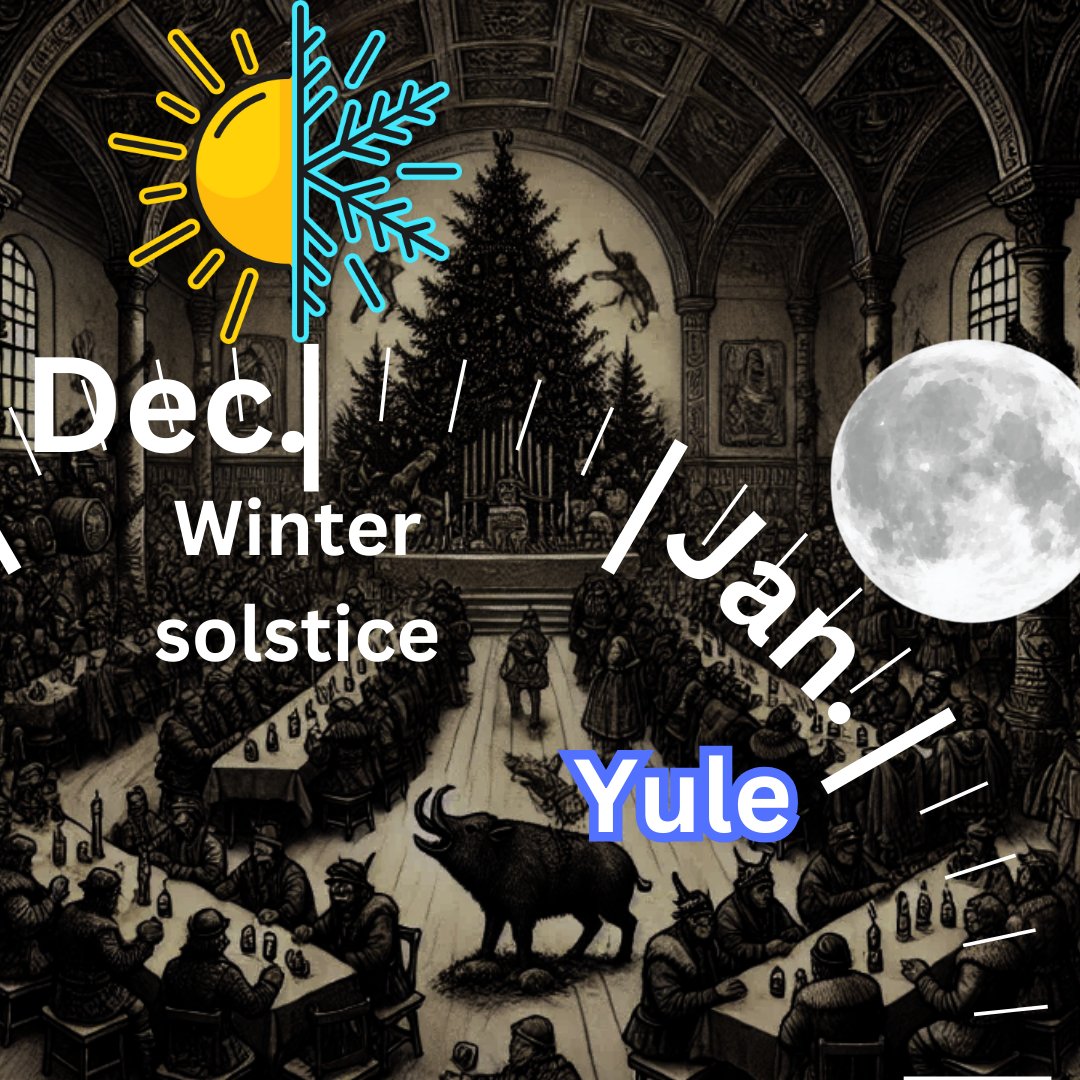
When is Yule?
Share
When is Yule 2024?
Many people mistakenly believe Yule is a pagan holiday tied directly to the Winter Solstice, largely due to modern interpretations introduced by neo-pagan or Wicca practitioners who lacked knowledge of its historical roots. The simple answer, according to the original pre-Christian sources, Yule would have been on the full moon in our modern month of January and was only moved to December around the winter solstice after Christianity was established in the North of Europe. This year, Yule is on January 13th 2025. This article examines those oldest sources we have explaining why.
You can also find the link to our calendar with all the Norse holidays here.

Yule on the Winter Solstice?
While Yule was sometimes attested as being connected to the solstice, this connection wasn’t recorded until the 1600s by historians of the time. Scandinavian authors of the time such as Magnus Celsius, Olof Dalin and Olof Rudbeck. This was further repeated in the 1800s by German Scholars such as Jacob Grimm and Max Muller. This was of course long after Christianity was introduced into the North of Europe. To uncover the true pagan Norse Origins, we need to look at a much older source accounting the viking age.
When is Pagan Yule?
King Haakon the Good, the first Christian Viking king, altered the date of Yule in the mid-900s, aligning it with the birth of Jesus in an effort to convert the pagan Norse. During the Middle Ages, Christians often celebrated Jesus’ birth on the solstice, though other sources suggest December 24th or 25th(on the Julian calendar). On some calendars, these dates were essentially the same.
"King Hakon was a good Christian when he came to Norway; but as the whole country was heathen, with much heathenish sacrifice, and as many great people, as well as the favour of the common people, were to be conciliated, he resolved to practice his Christianity in private. But he kept Sundays, and the Friday fasts, and some token of the greatest holy-days. He made a law that the festival of Yule should begin at the same time as Christian people held it, and that every man, under penalty, should brew a meal of malt into ale, and therewith keep the Yule holy as long as it lasted. Before him, the beginning of Yule, or the slaughter night, was the night of mid-winter (Full moon in Jan.), and Yule was kept for three days thereafter."
-Saga of Hákon góði ch. 15
However, the original Yule, or Jól, referred to as the "midwinter sacrifice" in many Norse sources, took place in January. Thietmar of Merseburg, a first-hand chronicler, explicitly noted Yule as a January event.
"Because I have heard strange stories about their ancient sacrifices, I will not allow the practice to go unmentioned. In those parts the center of the kingdom is called Lederun (Lejre), in the region of Selon (Sjælland), all the people gathered every nine years in January, that is after we have celebrated the birth of the Lord [Jan 6th], and there they offered to the gods ninety-nine men and just as many horses, along with dogs and cocks— the later being used in place of hawks."
-The Chronicon of Thietmar of Merseburg, 10th century
Note here that Thietmar mentions that this midwinter sacrifice was practiced only every 9 years. However, other Norse sagas clealry mention the midwinter sacrifice of Jól was an annual celebration. This is further supported by Anglo-Saxon sources. Bede records in the 8th century, during the transition period of the related Germanic pagan people, the Anglo-Saxons also observed their version of Yule corresponding to sometime in January. The text shows 2 month names corresponding to "Before" & "After Yule" being located around December. However, remember that this was before our modern Gregorian calendar was founded and they would have been operating with the Julian calendar at the time. This would have placed the actual celebration of Yule either in the last few days of December or in early January corresponding to our modern calendar.
Se mōnaþ is nemned on Leden Decembris, and on ūre geþeōde se ǣrra geōla, forðan ða mōnþas twegen syndon nemde ānum naman, ōðer se ǣrra geōla, óðer se æftera.
The month is called in Latin December, and in our language geōla for two months enjoy the same name; the first one Se Ǣrra Geola [The Preceding Yule] and the other Se Æftera [The Following].
-Bede, De temporum ratione, 725ce
In addition, there was an even older related Germanic people called the Goths who settled Eastern Europe that also placed their month corresponding to Yule in what would have been January. calendars and even an older Gothic calendar, which also align Yule with January. The Gothic calendar preserved in the Codex Ambrosianus A, which dates to the 5th century CE includes the month name fruma jiuleis ("first Yule"), providing concrete evidence that Yule was celebrated among the Goths. This shows that Yule is not just a "Viking" or "Norse" thing, but a tradition observed by all Germanic peoples a their roots.
Exactly When is Yule Celebrated?
Knowing that the original pagan Yule takes place in our modern month of January, this timing makes perfect sense, as Yule was considered midwinter in the Germanic calendar, which divided the year into two seasons: winter (lasting six months) and summer (lasting six or seven months, depending on leap years). Midwinter would naturally fall three moons after the Norse Vetrnætr (the start of winter) or Winterfylleth in pagan England, which occurred at the full moon in our modern October time. Three moons after this brings us to the full moon in January.
“When an embolismic year occurred (that is, one of 13 lunar months) they assigned the extra month to summer, so that three months together bore the name ‘‘Litha’’; hence they called [the embolismic] year ‘‘Thrilithi’’. It had four summer months, with the usual three for the other seasons. But originally, they divided the year as a whole into two seasons, summer and winter, assigning the six months in which the days are longer than the nights to summer, and the other six to winter.”
-Bede, De Ratione Temporum 725ce
Also, remember that many sources spanning almost 2000 years accounting for all kinds of spiritual traditions are said to follow the lunar cycles. The earliest of these sources dates to roman times in accounts on the Germanic tribes.
"Affairs of smaller moment the chiefs determine: about matters of higher consequence the whole nation deliberates; yet in such sort, that whatever depends upon the pleasure and decision of the people, is examined and discussed by the chiefs. Where no accident or emergency intervenes, they assemble upon stated days, either, when the moon changes, or is full: since they believe such seasons to be the most fortunate for beginning all transactions. Neither in reckoning of time do they count, like us, the number of days but that of nights."
-Tacitus, Germania 1st century
When accounting for the famous pre-Christian "blots" (blood sacrifices) these should not be done after the full moon has passed and has begun to wane. This would make the actual day of Yule being the full moon after the winter solstice(or sometimes the full moon after the new moon following the solstice). This would be the time for the Yule sacrifice and the celebrations would follow for 3 days as mentioned in the Saga of Haakon the Good(noted above) and at least 5 other Norse sagas.
The Primstav, traditional Norwegian calendar sticks found in the archology, also supports this timing, often marking the event with a snowflake symbol, referred to as Hökunótt. The earliest of these calendars date to the 12th century, but have clear connections to much older pagan tradition. The very name Hökunótt which is what this day has been referred to all the way up until recent centuries for example is recorded exactly the same from the time of viking King Haakon. However, it’s important to note that on a lunar calendar, the exact date of Yule would have shifted slightly each year.

Yule according to top modern Scholars
This topic is explored in greater depth by leading Scandinavian scholars, such as Andreas Norberg, Christofer Visted and Hilmar Stigum. Unfortunately, the best resources are currently only available in Scandinavian languages. But for Scandinavian readers you can find these books here on our Amazon reading list.
https://www.amazon.com/shop/norsemagicandbeliefs


For a detailed explanation of all the sources on Yule and exactly how it was celebrated, check out our full in depth blog post here.
You can also find our calendar for sale going over all the pagan holidays here!

God Yule!
